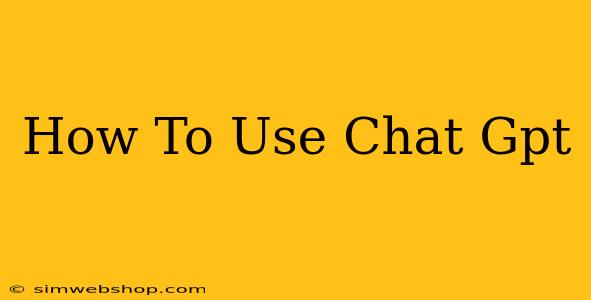ChatGPT, the revolutionary AI chatbot, has taken the world by storm. But navigating its capabilities can feel overwhelming, especially for newcomers. This comprehensive guide will walk you through everything you need to know, from basic usage to advanced techniques, empowering you to unlock ChatGPT's full potential.
Getting Started: Your First ChatGPT Interaction
Before you dive in, you'll need access to ChatGPT. While there might be various platforms offering similar services, the official ChatGPT platform provides the most authentic and updated experience.
Once you have access, the interface is surprisingly intuitive. The core of ChatGPT is a simple text box. This is where you'll type your prompts – your questions, requests, or instructions for the AI.
Here are some examples of simple prompts to get you started:
- "What is the capital of France?" (A straightforward factual question)
- "Write a short poem about a cat." (A creative request)
- "Explain quantum physics in simple terms." (A complex topic simplified)
- "Translate 'Hello, how are you?' into Spanish." (A translation task)
The beauty of ChatGPT lies in its adaptability. Experiment! Try different phrasing, and see how the AI responds.
Mastering the Art of Prompt Engineering: Getting Better Results
The key to unlocking ChatGPT's true power lies in prompt engineering. This is the art of crafting effective and precise prompts to elicit the desired response. Here are some tips for crafting better prompts:
Be Specific:
Vague prompts lead to vague answers. Instead of asking "Write a story," try "Write a short science fiction story about a robot who discovers emotions." The more detail you provide, the better the results.
Use Keywords Effectively:
Think about the terms and concepts that are central to your request. Incorporating relevant keywords will help ChatGPT understand your intentions more accurately. For example, if you need a marketing plan, include terms like "target audience," "marketing channels," and "ROI."
Specify the Desired Format:
Tell ChatGPT how you want your response formatted. Do you need a bulleted list, a poem, an essay, code, or something else? Explicitly stating your desired format will greatly improve the quality of the output. For example: "List five benefits of regular exercise in a bulleted list."
Iterate and Refine:
Don't be afraid to experiment and refine your prompts. If your first attempt doesn't yield the desired results, try rephrasing your prompt, adding more detail, or changing the keywords. The iterative process is crucial for mastering prompt engineering.
Advanced ChatGPT Techniques: Unlocking Hidden Capabilities
Once you've mastered the basics, you can explore ChatGPT's advanced capabilities:
Contextual Conversations:
ChatGPT remembers previous interactions within a single conversation. This allows you to build upon earlier requests and have more nuanced and context-rich dialogues.
Role Playing:
Assign roles to yourself and the AI. For example, you could ask ChatGPT to act as a Shakespearean playwright or a technical support agent. This can lead to surprising and creative results.
Code Generation:
ChatGPT can generate code in various programming languages. This can be incredibly helpful for developers needing assistance with specific tasks or exploring different coding approaches.
Creative Writing:
ChatGPT is a powerful tool for creative writers. It can help with brainstorming, overcoming writer's block, developing characters, and generating different narrative styles.
Conclusion: Embracing the ChatGPT Revolution
ChatGPT is more than just a chatbot; it's a versatile tool that can assist with a wide range of tasks. By mastering the art of prompt engineering and exploring its advanced features, you can harness its power to improve your productivity, boost your creativity, and unlock a whole new world of possibilities. So go ahead, experiment, and discover the incredible potential of ChatGPT!

